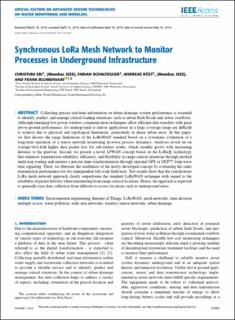Please use this identifier to cite or link to this item:
https://doi.org/10.21256/zhaw-3244Full metadata record
| DC Field | Value | Language |
|---|---|---|
| dc.contributor.author | Ebi, Christian | - |
| dc.contributor.author | Schaltegger, Fabian | - |
| dc.contributor.author | Rüst, Peter Andreas | - |
| dc.contributor.author | Blumensaat, Frank | - |
| dc.date.accessioned | 2019-05-29T08:34:51Z | - |
| dc.date.available | 2019-05-29T08:34:51Z | - |
| dc.date.issued | 2019 | - |
| dc.identifier.issn | 2169-3536 | de_CH |
| dc.identifier.uri | https://digitalcollection.zhaw.ch/handle/11475/17190 | - |
| dc.description.abstract | Collecting precise real-time information on urban drainage system performance is essential to identify, predict, and manage critical loading situations, such as urban flash floods and sewer overflows. Although emerging low-power wireless communication techniques allow efficient data transfers with great above-ground performance, for underground or indoor applications in a large coverage range are difficult to achieve due to physical and topological limitations, particularly in dense urban areas. In this paper, we first discuss the range limitations of the LoRaWAN standard based on a systematic evaluation of a long-term operation of a sensor network monitoring in-sewer process dynamics. Analyses reveal an-on average-five-fold higher data packet loss for sub-surface nodes, which steadily grows with increasing distance to the gateway. Second, we present a novel LPWAN concept based on the LoRa technology that enhances transmission reliability, efficiency, and flexibility in range-critical situations through meshed multi-hop routing and ensures a precise time-synchronization through optional GPS or DCF77 long-wave time signaling. Third, we illustrate the usefulness of the newly developed concept by evaluating the radio transmission performance for two independent full-scale field tests. Test results show that the synchronous LoRa mesh network approach clearly outperforms the standard LoRaWAN technique with regard to the reliability of packet delivery when transmitting from range-critical locations. Hence, the approach is expected to generally ease data collection from difficult-to-access locations such as underground areas. | de_CH |
| dc.language.iso | en | de_CH |
| dc.publisher | IEEE | de_CH |
| dc.relation.ispartof | IEEE Access | de_CH |
| dc.rights | http://creativecommons.org/licenses/by/3.0/ | de_CH |
| dc.subject | Environmental engineering | de_CH |
| dc.subject | Internet of Things | de_CH |
| dc.subject | LoRaWAN | de_CH |
| dc.subject | Mesh network | de_CH |
| dc.subject | Water pollution | de_CH |
| dc.subject | Wide area network | de_CH |
| dc.subject | Wireless sensor network | de_CH |
| dc.subject | Urban drainage | de_CH |
| dc.subject.ddc | 004: Informatik | de_CH |
| dc.title | Synchronous LoRa mesh network to monitor processes in underground infrastructure | de_CH |
| dc.type | Beitrag in wissenschaftlicher Zeitschrift | de_CH |
| dcterms.type | Text | de_CH |
| zhaw.departement | School of Engineering | de_CH |
| zhaw.organisationalunit | Institute of Embedded Systems (InES) | de_CH |
| dc.identifier.doi | 10.21256/zhaw-3244 | - |
| dc.identifier.doi | 10.1109/ACCESS.2019.2913985 | de_CH |
| zhaw.funding.eu | No | de_CH |
| zhaw.originated.zhaw | Yes | de_CH |
| zhaw.pages.end | 57677 | de_CH |
| zhaw.pages.start | 57663 | de_CH |
| zhaw.publication.status | publishedVersion | de_CH |
| zhaw.volume | 7 | de_CH |
| zhaw.publication.review | Peer review (Publikation) | de_CH |
| Appears in collections: | Publikationen School of Engineering | |
Files in This Item:
| File | Description | Size | Format | |
|---|---|---|---|---|
| 08703036-3.pdf | Synchronous LoRa Mesh Network to Monitor Processes in Underground Infrastructure | 5.74 MB | Adobe PDF |  View/Open |
Show simple item record
Ebi, C., Schaltegger, F., Rüst, P. A., & Blumensaat, F. (2019). Synchronous LoRa mesh network to monitor processes in underground infrastructure. IEEE Access, 7, 57663–57677. https://doi.org/10.21256/zhaw-3244
Ebi, C. et al. (2019) ‘Synchronous LoRa mesh network to monitor processes in underground infrastructure’, IEEE Access, 7, pp. 57663–57677. Available at: https://doi.org/10.21256/zhaw-3244.
C. Ebi, F. Schaltegger, P. A. Rüst, and F. Blumensaat, “Synchronous LoRa mesh network to monitor processes in underground infrastructure,” IEEE Access, vol. 7, pp. 57663–57677, 2019, doi: 10.21256/zhaw-3244.
EBI, Christian, Fabian SCHALTEGGER, Peter Andreas RÜST und Frank BLUMENSAAT, 2019. Synchronous LoRa mesh network to monitor processes in underground infrastructure. IEEE Access. 2019. Bd. 7, S. 57663–57677. DOI 10.21256/zhaw-3244
Ebi, Christian, Fabian Schaltegger, Peter Andreas Rüst, and Frank Blumensaat. 2019. “Synchronous LoRa Mesh Network to Monitor Processes in Underground Infrastructure.” IEEE Access 7: 57663–77. https://doi.org/10.21256/zhaw-3244.
Ebi, Christian, et al. “Synchronous LoRa Mesh Network to Monitor Processes in Underground Infrastructure.” IEEE Access, vol. 7, 2019, pp. 57663–77, https://doi.org/10.21256/zhaw-3244.
Items in DSpace are protected by copyright, with all rights reserved, unless otherwise indicated.